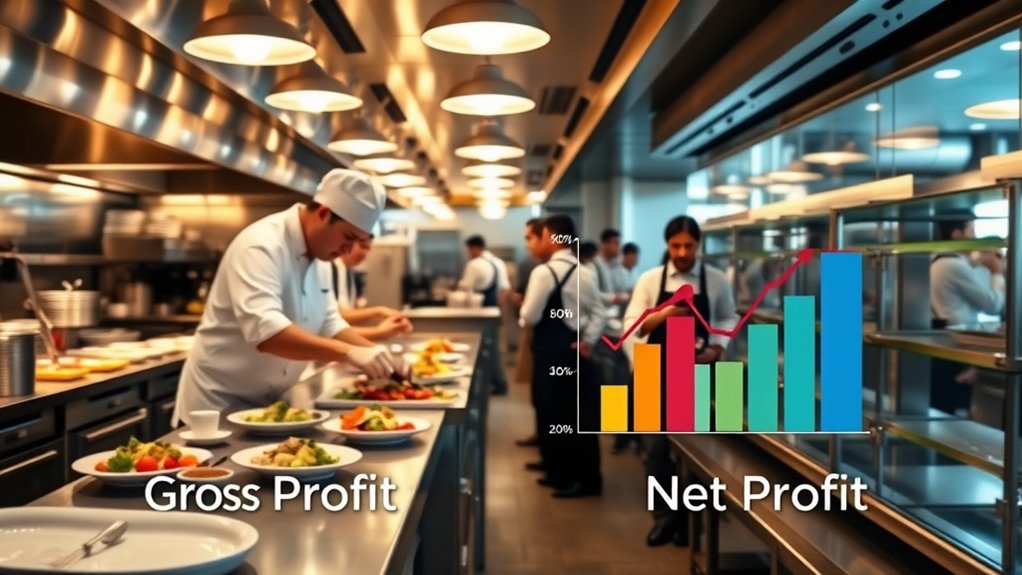In foodservice, gross profit is your total sales minus the cost of goods sold, showing how efficiently you produce and sell menu items. Net profit takes this further by subtracting operating expenses, wages, rent, and taxes, revealing your actual profit or loss. Understanding both metrics helps you make smarter decisions about pricing and costs. Exploring these differences more deeply can give you valuable insights into improving your restaurant’s financial health.
Key Takeaways
- Gross profit equals total sales minus cost of goods sold (COGS), indicating operational efficiency in food production and sales.
- Net profit subtracts operating expenses, taxes, and other costs from gross profit, reflecting overall profitability and financial health.
- Gross profit focuses on core menu profitability, while net profit accounts for all expenses and overheads.
- Calculating gross profit involves sales and COGS; net profit requires detailed expense accounting.
- Both metrics guide pricing, cost control, and resource allocation for sustainable foodservice operations.
Defining Gross Profit and Its Significance in Foodservice

Gross profit is the amount of money your foodservice business earns after subtracting the cost of goods sold (COGS) from total sales. This figure shows how efficiently you produce and sell your menu items, highlighting the core profitability of your core operations. When you track gross profit, you see how much money remains to cover operating expenses and generate profit. It’s a vital indicator of your pricing strategy and cost control. If your gross profit is low, it suggests high food costs or underpricing. By understanding this number, you can make informed decisions about menu pricing, sourcing ingredients, and managing waste. Gross profit provides a clear picture of your business’s fundamental financial health, setting the stage for further analysis of overall profitability.
Understanding Net Profit and Its Role in Business Health

While gross profit shows how efficiently your foodservice business produces and sells its menu items, net profit reveals the true bottom line by accounting for all expenses. It’s the amount left over after deducting operating costs, wages, rent, utilities, taxes, and other expenses from your gross profit. Understanding your net profit is essential because it reflects your business’s overall financial health and sustainability. If your net profit is low or negative, it indicates that expenses are eating into your earnings, and you may need to adjust pricing, reduce costs, or improve efficiency. Monitoring net profit regularly helps you make informed decisions, set realistic financial goals, and ensure your business remains profitable in the long run. Additionally, tracking contrast ratio can be useful in assessing the effectiveness of your visual displays, which can indirectly influence customer experience and sales.
Calculating Gross Profit: Key Components and Methodology

To accurately determine your gross profit, you need to understand its key components and how to calculate it correctly. Start by identifying your total revenue, which includes all sales from food and beverages. Next, determine your cost of goods sold (COGS), covering ingredients, supplies, and direct labor involved in preparing your menu items. Subtract COGS from total revenue to find your gross profit. This calculation shows how efficiently you produce and sell your offerings before accounting for other expenses. Keep detailed records of sales and inventory to ensure accurate calculations. Regularly reviewing these figures helps you identify profit margins for different menu items and adjust pricing or cost controls accordingly. Mastering this methodology is essential for informed financial decision-making. Additionally, understanding the cost structure of your foodservice operation can help optimize your profitability and improve overall financial health.
Determining Net Profit: Expenses and Deductions to Consider

Understanding your net profit requires subtracting all operating expenses, taxes, and other deductions from your gross profit. These costs include rent, salaries, utilities, supplies, and taxes. You must account for all expenses to accurately determine your profitability. Here’s a quick overview: cybersecurity vulnerabilities can impact financial data security during transactions, making it essential to implement comprehensive protection measures.
Comparing Gross Profit and Net Profit: Practical Examples in Foodservice

To better understand the difference between gross and net profit, consider real-world examples that highlight revenue versus expenses. You’ll see how profit margins are calculated and what factors impact each figure. These practical cases help you grasp the financial health of a foodservice operation clearly and effectively. Paying attention to revenue streams and their management is essential for accurate financial analysis.
Revenue vs. Expenses
Have you ever wondered how gross profit and net profit differ in a foodservice operation? It all comes down to revenue and expenses. Revenue is the total money you bring in from sales, like food and drinks. Expenses include everything you spend to run your business—cost of ingredients, staff wages, rent, utilities, and more. Gross profit is calculated by subtracting the cost of goods sold from your revenue, showing how much money you make before other costs. Net profit, on the other hand, deducts all expenses from revenue, revealing your actual profit. Understanding this difference helps you see how well your business is performing. Focusing on managing expenses alongside revenue guarantees you stay profitable and can make informed decisions for growth. Additionally, being aware of water-related operational costs, such as water usage and conservation efforts, can impact your overall expenses.
Profit Margin Calculation
Calculating profit margins helps you evaluate your foodservice business’s financial health by comparing gross and net profits. To find your gross profit margin, divide your gross profit by total revenue and multiply by 100. This shows how efficiently you’re producing and selling food. For net profit margin, divide your net profit by total revenue and multiply by 100, revealing your overall profitability after all expenses. These percentages allow you to compare performance over time or against industry benchmarks. A higher gross profit margin indicates strong sales and cost control at the production level, while a higher net profit margin reflects effective expense management. Regularly calculating these margins enables you to identify areas needing improvement and make informed decisions for growth. Additionally, understanding how shifting gears smoothly can improve operational efficiency in your business can indirectly impact your profitability.
Real-World Examples
Understanding the difference between gross profit and net profit becomes clearer when you look at real-world examples from foodservice businesses. For instance, a restaurant with $500,000 in sales might have $200,000 in cost of goods sold, earning a gross profit of $300,000. After deducting $150,000 in operating expenses, taxes, and other costs, the net profit drops to $150,000. Here’s a quick comparison:
| Revenue | Gross Profit | Net Profit |
|---|---|---|
| $500,000 | $300,000 | $150,000 |
| $600,000 | $350,000 | $180,000 |
| $400,000 | $180,000 | $80,000 |
| $700,000 | $420,000 | $210,000 |
These figures show how expenses impact profitability at different stages, clarifying the key differences.
How These Metrics Influence Decision-Making and Strategic Planning

Understanding how gross and net profit impact your business helps you make smarter decisions about where to focus resources. These metrics reveal which areas boost profitability and where costs may be dragging you down. By using this information, you can develop strategies that improve overall financial health and growth. Recognizing financial statement analysis can further enhance your ability to interpret these metrics effectively.
Impact on Profitability
Gross profit and net profit are essential tools that directly influence your business decisions and strategic planning. They help you identify which areas are profitable and where to cut costs or invest more. A higher gross profit indicates your core operations are efficient, guiding pricing strategies and menu adjustments. Net profit reveals your overall financial health, impacting decisions on expansion or cost management. By analyzing these metrics regularly, you can spot trends, set realistic goals, and adapt quickly to market changes. Understanding financial terms and jargon such as gross profit and net profit enables you to make more informed decisions.
Strategic Resource Allocation
Your profit margins directly shape how you allocate resources across your foodservice operations. When gross profit is high, you have more flexibility to invest in quality ingredients, staff training, or marketing efforts. Conversely, if net profit margins are slim, you might need to tighten spending and focus on cost control. Understanding these metrics helps you prioritize areas that improve profitability, such as reducing waste or optimizing menu prices. Strategic resource allocation becomes more effective when grounded in accurate profit data, guiding you to invest in high-margin items or streamline low-margin areas. By regularly analyzing gross and net profit, you make informed decisions that align expenses with revenue, ensuring sustainable growth and operational efficiency. This approach keeps your business competitive and profitable over the long term, especially when considering the latest economic growth factors and market trends.
Frequently Asked Questions
How Do Seasonal Changes Affect Gross and Net Profit in Foodservice?
Seasonal changes impact your foodservice profits by shifting sales and costs. During busy seasons, you might see higher gross profit due to increased sales, but net profit may fluctuate depending on additional costs like staffing or inventory. Off-peak times can lower gross profit as sales decline, while fixed costs remain, squeezing your net profit. Planning for these seasonal fluctuations helps you optimize pricing, inventory, and staffing to maintain profitability year-round.
What Errors Are Common When Calculating Gross or Net Profit?
Like a lighthouse guiding ships, accurate calculations keep your profits afloat. You often make errors by forgetting to include all expenses, such as labor or overhead costs, when calculating net profit. Similarly, misclassifying costs as either gross or net can lead to misleading figures. Double-check your numbers, use consistent methods, and avoid rushing through calculations. Precision guarantees you truly understand your business’s profitability and keeps your financial ship steady.
How Do Different Restaurant Formats Impact Profit Margins?
You should consider how various restaurant formats influence profit margins. Fast-food outlets often have higher margins due to quick turnover and lower costs, while fine dining establishments typically face higher expenses, reducing margins. Casual dining sits somewhere in between. By understanding the operational costs and customer expectations unique to each format, you can better strategize to optimize your profit margins and guarantee financial success across different restaurant types.
What Tax Implications Influence Net Profit Calculations?
When calculating net profit, you need to take into account taxes, since they directly reduce your earnings. Tax implications vary based on your business structure, location, and revenue. You might face income taxes, sales taxes, or other local levies. Properly accounting for these taxes ensures you accurately determine your net profit. Staying compliant with tax laws also helps avoid penalties and keeps your financial health transparent and sustainable.
How Can Industry Benchmarks Improve Profit Analysis Accuracy?
Your profit analysis can skyrocket from industry benchmarks, turning ordinary calculations into a crystal-clear view of your financial health. By comparing your data to industry standards, you identify areas to boost efficiency and cut costs. These benchmarks serve as your compass, guiding smarter decisions. You’ll gain a sharper understanding of where you stand, making your profit strategies more precise, effective, and ultimately, more profitable.
Conclusion
Think of your foodservice business like a ship charting the seas. Gross profit is your cargo—what you earn before the storms of expenses hit. Net profit is what remains after weathering those storms. Just as a ship’s success depends on both its cargo and its resilience, understanding both profits helps you steer confidently toward growth. Keep your eye on both metrics, and you’ll navigate your business to calmer waters and brighter horizons.









